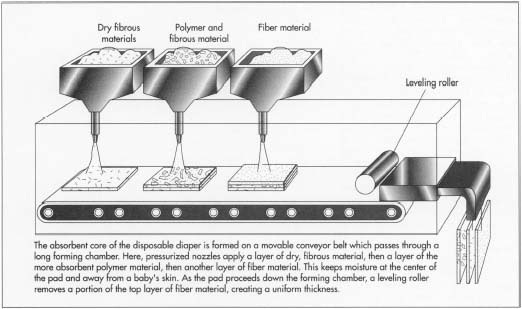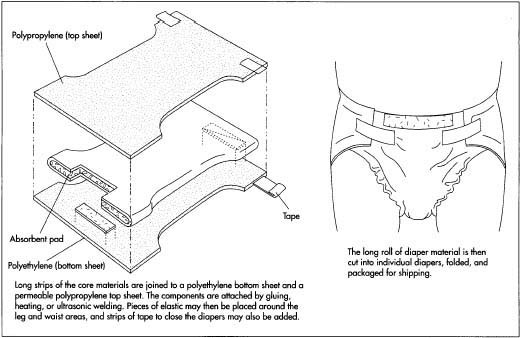
How Disposable Diaper Production
2022-10-20 11:52
The Manufacturing Process
Formation of the absorbent pad
1 The absorbent pad is formed on a movable conveyer belt that passes through a long "forming chamber." At various points in the chamber, pressurized nozzles spray either polymer particles or fibrous material onto the conveyor surface. The bottom of the conveyor is perforated, and as the pad material is sprayed onto the belt, a vacuum is applied from below so that the fibers are pulled down to form a flat pad.
At least two methods have been employed to incorporate absorbent polymers into the pad. In one method the polymer is injected into the same feed stock that supplies the fibers. This method produces a pad that has absorbent polymer dispersed evenly throughout its entire length, width, and thickness. The problems associated with method are that loss of absorbent may occur because the fine particles are pulled through the perforations in the conveyor by the vacuum. It is therefore expensive and messy. This method also causes the pad to absorb unevenly since absorbent is lost from only one side and not the other.
A second method of applying polymer and fiber involves application of the absorbent material onto the top surface of the pad after it has been formed. This method produces a pad which has absorbent material concentrated on its top side and does not have much absorbency throughout the pad. Another disadvantage is that a pad made in

this way may lose some of the polymer applied to its surface. Furthermore, this approach tends to cause gel blocking, since all the absorbent is on the outside of the pad. The moisture gets trapped in this outer layer and does not have a chance to diffuse to the center. This blockage holds moisture against the skin and can lead to discomfort for the wearer.
These problems are solved by controlling the mixture polymer and fibrous material. Multiple spray dispensers are used to apply several layers of polymer and fiber. As the fiber is drawn into the chamber and the bottom of the pad is formed, a portion of the polymer is added to the mix to form a layer of combined polymer and fiber. Then more pure fiber is pulled on top to give a sandwich effect. This formation creates a pad with the absorbent polymer confined to its center, surrounded by fibrous material. Gel blockage is not a problem because the polymer is concentrated at core of pad. It also solves the problem of particle loss since all the absorbent is surrounded by fibrous material. Finally, this process is more cost effective because it distributes the polymer just where it is needed.
2 After the pad has received a full dose of fiber and polymer, it proceeds down the conveyor path to a leveling roller near the outlet of the forming chamber. This roller removes a portion of the fiber at the top of the pad to make it a uniform thickness. The pad then moves by the conveyor through the outlet for subsequent operations to form the competed diaper.
Preparation of the nonwoven
3 Sheets of nonwoven fabric are formed from plastic resin using the meltblown process as described above. These sheets are produced as a wide roll known as a "web," which is then cut to the appropriate width for use in diapers. There is a web for the top sheet and another for the bottom sheet. It should be noted that this step does not necessarily occur in sequence after pad formation because the nonwoven fabrics are often made in a separate location. When the manufacturer is ready to initiate diaper production these large bolts of fabric are connected to special roller equipment that feeds fabric to the assembly line.

4 At some point in the process, stretched elastic bands are attached to the backing sheet with adhesive. After the diaper is assembled, these elastic bands contract and gather the diaper together to ensure a snug fit and limit leakage.
Assembly of the components
5 At this point in the process there are still three separate components, the absorbent pad, the top sheet, and the backing sheet. These three components are in long strips and must be joined together and cut into diaper-sized units. This is accomplished by feeding the absorbent pad onto a conveyor with the polyethylene bottom sheet. The polypropylene top sheet is then fed into place, and the compiled sheets are joined by gluing, heating, or ultrasonic welding. The assembled diaper may have other attachments, such as strips of tape or Velcro ™ , which act as closures.
6 The long roll is then cut into individual diapers, folded, and packaged for shipping.
Byproducts/Waste
Diaper production does not produce significant byproducts; in fact the diaper industry uses the byproducts of other industries. The absorbent polymers used in diaper production are often left over from production lines of other chemical industries. The polymer particles are too small for other applications, but they are well suited for use in diapers. In diaper production, however, considerable amounts of both nonwoven material and polymer particles are wasted. To minimize this waste, the industry tries to optimize the number of diapers obtained from every square yard (meter) of material. Furthermore, every attempt is made to recover the excess fiber and polymer material used in the forming chamber. However, this is not always possible due to clogging of filters and other losses.
Quality Control
There are several methods used to control the quality of disposable diapers, and most of these relate to the product's absorbency. One key is to make sure the polymer/fiber ratio in the absorbent pad is correct. Too much variation will impact the diaper's ability to soak up moisture. Industry trial and error has shown that for optimal performance and cost, the fiber to particle ratio should be about 75:25 to 90:10. Even more critical than this ratio are the size and distribution of these particles. It has been established that particles with mass median particle size greater than or equal to about 400 microns work very well with the fibers to enhance the rate at which the fluid is transported away from the body. If the particles vary much outside this range, gel blocking may occur.
There are several standard tests the industry uses to establish diaper absorbency. One is referred to as Demand Wettability or Gravimetric Absorbance. These tests evaluate what is are commonly referred to as Absorbance Under Load (AUL). AUL is defined as the amount of 0.9% saline solution absorbed by the polymers while being subjected to pressure equivalent to 21,000 dynes, or about 0.30 lb/sq in (0.021 kg/sq cm). This test simulates the effect of a baby sitting on a wet diaper. If the diaper has an absorbency of at least 24 ml/g after one hour, the quality is considered acceptable.
Other quality control factors besides absorbency are related to the diaper's fit and comfort. Particular attention must be paid to the melt characteristics of the nonwoven fabrics used to form the diaper's shell. If materials with different melting points are used, the material that melts the quickest may become too soft and stick to the assembly apparatus. When the fabric is pulled off it may be left with a rough surface that is uncomfortable to the user. Finally, the alignment of the components must be carefully checked or leakage may result.
Get the latest price? We'll respond as soon as possible(within 12 hours)















